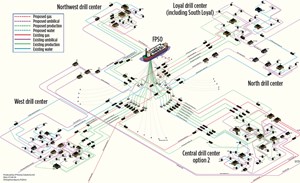Rising to the challenge: Delivering UKCS’ largest riser system for BP’s Schiehallion field
Situated 175 km to the west of Shetland, Scotland, BP-operated Schiehallion field has been one of the biggest success stories for the UK Continental Shelf (UKCS). Discovered in 1993, the field is estimated to hold more than 2 Bbbl of oil. First oil was produced in 1998. In 2011, BP took the decision to extend the life of this reservoir through the Quad 204 development project. This reconditioning of the field will see the existing FPSO replaced, subsea infrastructure renewed, and 12 more wells drilled to increase the total number from 52 to 64. The aim of the project is to extend the field life to 2036 or beyond, and to see it produce an additional 400 MMbbl. Technip in the UK has been tasked to support BP with the recovery and replacement of the field’s subsea system and the hook-up to the new, purpose-built FPSO, Glen Lyon, Fig. 1.
BACKGROUND
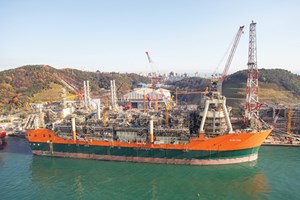
The North Atlantic Ocean is a harsh environment for oilfield operations, particularly the West of Shetland area. All planning, development and equipment have to be geared to withstand waves as high as 30 m, and up to 60 m of FPSO lateral movement. A daily average of just one half-hour of sunlight throughout December can have a significant impact on work practices.
Historically, during the summer period, there has been as much down time from high current through the water column, as from the conditions on the surface (e.g. wind and waves). It is common for different current speeds and directions to go through the water profile, with Atlantic current influences and the movement of water from the Arctic adding to the complexity.
FLEXIBLE RISERS
As a pioneer in flexible-pipe technology since the 1970s, Technip has long-standing experience in developing, manufacturing and installing successful subsea systems. However, even by those standards, the Quad 204 task on hand was immense, with 21 risers required for the new FPSO—one of the most extensive riser systems on the UKCS.
Harsh environmental conditions, combined with the size and scale of the project, were the main considerations in designing the subsea hardware. Technip has worked on West of Shetland projects for the past 20 years, during which time the company has garnered much experience in dealing with the testing of subsea elements.
The flexible pipes were manufactured safely, and to the highest-quality standards, at Technip’s Le Trait plant in France. This task required a significant portion of the factory capacity in 2014, due to the technical complexity of the flexible pipes. A total of 21 risers and 78 flexible jumpers, were required. Five different forms of risers and nine varieties of jumpers are included in the system, ranging from 2.5-in. gas-lift jumpers to 11-in. water injection risers. About 200 end fittings were required—a significant operation, considering the installation of an end fitting is predominantly a manual process, with many different intricate elements that need to be installed.
ANCILLARY EQUIPMENT
Technip’s scope of work also included the design and supply of the ancillary equipment, including clamps, tethers and buoyancy modules. Design analysis was conducted by the Technip engineering team at the outset to ensure that the proving concepts were suitable, as well as providing appropriate dimensions for the flexible structures, end fittings and bend stiffeners. A detailed analysis also was undertaken on riser fatigue. Extreme duty and interference analyses also were conducted to ensure a safe riser configuration, and to prevent any clashing of the risers, once installed.
As part of the project qualification process, the bend stiffener system, that would form part of the new Quad 204 riser structure, also had to be tested extensively. The company had to prove, before the project started, that it could successfully scale up the existing technology, both in terms of application and manufacturing, and that the system had the stamina and dexterity to withstand the demands of the surrounding environment for up to 20 years.
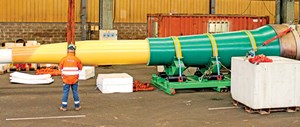
The riser bend stiffeners required for the Glen Lyon FPSO had to be designed as a two-part assembly to allow for fabricating on a massive scale and to allow the riser to be spooled onto a standard installation reel. Installation is, therefore, much more complicated than for a single part, as the outer bend stiffener has to be installed offshore. The integrity of such a large piece of equipment was established by undertaking a full-scale qualification program at Technip’s research center, applying both fatigue and extreme loading to the stiffener. The process was intended to demonstrate the full extent of the stiffener’s capabilities under duress, namely to simulate the most severe conditions that will be experienced during its service life.
A comprehensive site integration test (SIT) was performed in Le Trait (Fig. 2) to ensure that the riser system was fully compatible for the installation process. Particular focus was placed on the bend stiffener, bend stiffener connector (BSC) system, and the riser installation pull head, which allows for diverless connection of the two-part bend stiffener system to the I-tube of the FPSO. Due to the large scale of the subsea system, the fabrication process took two years.
PRE-INSTALLATION PROCESS
Once the manufacture and testing were complete, the flexible riser pipe was spooled onto 21 reels and shipped to Lerwick, Shetland. The installation process had its own specific challenges. To hook up all of the new risers (and two new umbilicals and 20 new moorings) in a single offshore season, it was necessary to pre-install and wet-store the 21 risers and shorten the hook-up critical path, as heavy, weather-sensitive construction is restricted to a period from May through August.
Over the last three years, a wave-rider current profiler was installed just outside Schiehallion field, and its output is shared with all the vessels working in the field. In addition, the experience of the ROV teams working in these conditions was valuable in maximizing the use of every minute possible in such a short working season.
Technip had been involved in modeling and analysis of the best configuration for wet-store and recovery since BP commissioned a study on the subject in 2006. Technip focused the study on efficient pick-up and minimizing the riser installation schedule once the FPSO arrived on site. Various seabed, wet-store routing configurations were examined. The Reverse Pliant Wave configuration was selected to achieve maximum installation flexibility. The hook-up method was designed carefully to recover the riser onto the construction vessel and flip the configuration, rather than twisting the riser. As such, any riser can be installed, to ensure that first-oil risers receive priority. This method also mitigates any risk of the effect of residual torque in the riser dynamic section, which would be the case, where the risers are rotated.
In being pre-installed, risers are connected to the seabed, but they are then looped back on themselves so that the end, which will ultimately be connected to the FPSO, is laid on the seabed away from the FPSO. This configuration results in a notable advantage—a significant amount of work is done before the FPSO arrives, which makes the start-up more efficient. Riser pre-installation on the construction vessel takes between four to five days, depending on the size and configuration of the risers.
Each of the risers is individually designed and constructed. While some risers may provide the same services as another, the quantity of buoyancy, riser protection, and position of the tether clamps and foundations allow each to develop a unique configuration. The reason behind such specific design is to avoid subsea clashing: 20 moorings, 21 risers and two dynamic umbilicals create a congested water column.
More than 7,000 individual components made up the riser systems. Every component was checked, tested, manifested, boxed, re-checked and loaded onto the vessel. The supply project team was responsible for the design and fabrication of the ancillary equipment, and had to ensure that the equipment provided was fit-for-purpose and quality control-checked after undergoing factory acceptance test (FAT) and system integration test (SIT).
The components were delivered to Technip’s Lerwick support base, where a team of riggers, technicians and engineers re-checked each box and separated all components for each riser. Prior to vessel mobilization, the riser kits were moved to a secure staging area on the base, where a manifest was taken once again. Once the components were loaded onto the vessel, the equipment was again checked, and all boxes were opened and manifested. This process of checking and rechecking was key to ensuring that no errors were found, once the kits had been shipped to the project site.
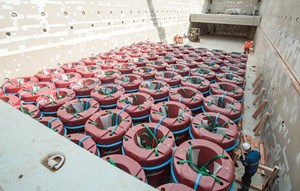
Installation of the ancillary components onto the risers was time-consuming and repetitive. For example, the risers each had up to 62 buoyancy modules fitted, a process that involves installing an internal clamp—tensioned to the riser pipe—and two half-shells which are, in turn, attached to the inner clamp, Fig. 3.
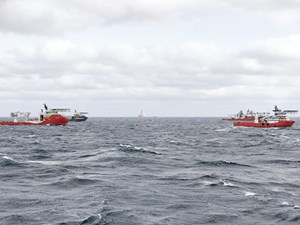
The decision to pre-install the risers had implications on the bend stiffeners, which are, by their nature, delicate pieces of equipment. Essentially large polyurethane moldings, the stiffeners must be handled with great care. At the same time, it was important to prevent damage during procedural and handling techniques on the installation vessel. By way of further mitigation, Technip developed a protective jacket to protect the inner bend stiffener, as it is laid down to the seabed between pre-installation and pick-up in 2016. During this time, the bend stiffeners were laid on a rubber subsea mat for added protection from any seabed anomalies.
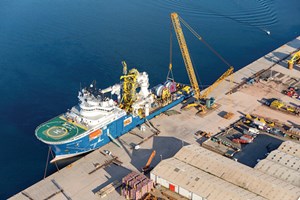
At the outset of the project, it was envisaged that there was only space for eight of the risers to be pre-installed. However, as a result of detailed analysis, and due to close collaboration and efficiency gains, by September 2015, all 21 risers had been laid successfully in position, awaiting the arrival of the Glen Lyon.
INSTALLATION
The autumn and winter of 2015-16 will see a continuation of procedure development and analysis in preparation for the pickup and FPSO hook up in summer 2016. Technip will trial as much of the construction vessel scope as possible over the months ahead, and will be responsible for various preparation works in the FPSO turret ahead of the hook-up program.
The Technip construction vessel North Sea Atlantic is expected to be mobilized in the first half of 2016, in Quad 2014. The vessel has an Open VLS (Vertical Laying System), which allows the tensioners to open. Installation of the first dynamic umbilical will enable the FPSO to start communicating with the wells, trees and manifolds. Thereafter, the vessel will embark on a four-month program of riser and umbilical installation. ![]()
- Advancing offshore decarbonization through electrification of FPSOs (March 2024)
- What's new in production (February 2024)
- Subsea technology- Corrosion monitoring: From failure to success (February 2024)
- U.S. operators reduce activity as crude prices plunge (February 2024)
- U.S. producing gas wells increase despite low prices (February 2024)
- U.S. oil and natural gas production hits record highs (February 2024)
- Applying ultra-deep LWD resistivity technology successfully in a SAGD operation (May 2019)
- Adoption of wireless intelligent completions advances (May 2019)
- Majors double down as takeaway crunch eases (April 2019)
- What’s new in well logging and formation evaluation (April 2019)
- Qualification of a 20,000-psi subsea BOP: A collaborative approach (February 2019)
- ConocoPhillips’ Greg Leveille sees rapid trajectory of technical advancement continuing (February 2019)

